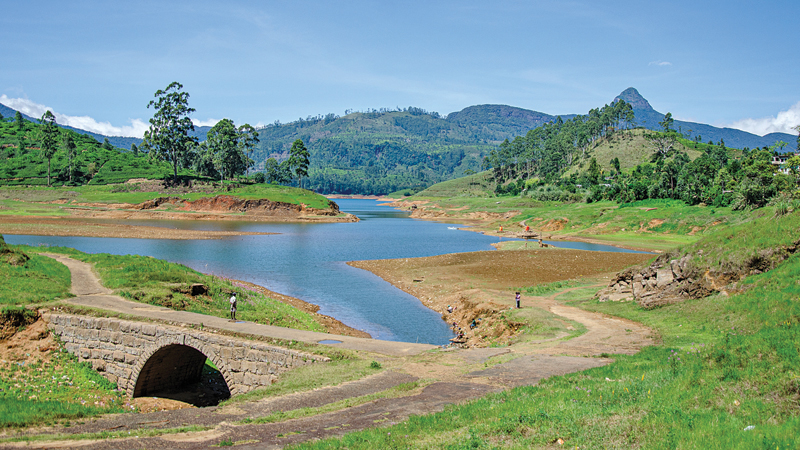 Tea estates lie over mist-laden hills and valleys as far as you can see. Shades of bright and light green carpet the hills and reflect a kaleidoscope of patterns as sunlight embraces them playfully from between the veils of mist that shroud the land creating a beautiful panorama.
Tea estates lie over mist-laden hills and valleys as far as you can see. Shades of bright and light green carpet the hills and reflect a kaleidoscope of patterns as sunlight embraces them playfully from between the veils of mist that shroud the land creating a beautiful panorama.
Sri Lanka’s central highland is home to an abundance of settings that leave you feeling blessed to witness the sheer beauty of nature. Among them is Maskeliya, a small town up in the hills where some of the most breathtaking landscapes on the island are found.
Maskeliya has a unique charm. A five-minute walk from the centre of the town takes you to beautiful tea estates.
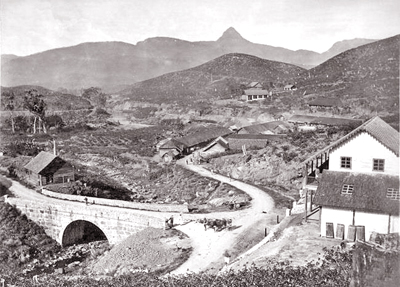
The Sri Pada peak and the old town of Maskeliya before
the reservoir being built during British period
– Picture courtesy Internet
Tea pluckers, whose day begins in the wee hours, are miles ahead as they move amid the greenery, their fingers swiftly plucking the tender leaves they collect in baskets tied to their backs. The tea leaves are sent to one of the nearby Tea Processing Plants, the modern name for the tall tea factories built of corrugated metal that dominate the lush green landscape.
I had always wanted to see Sri Pada (Adams’s Peak) from the higher elevation of the bank of the Moussekele reservoir. I missed that opportunity because the reservoir was dried up due to the prevailing drought in the area. This time, the scenery from the bank of the reservoir was amazing and almost like a picture postcard.
Last week, we featured the Maskeliya town and this is the second part where I am going to rediscover the old town of Maskeliya and its ruined monuments.
My second visit was based on two reasons. One, I have an old photograph of the Sri Pada peak in my collection dating back to the years 1800-1900, with which I wanted to compare the present one. The second, more obvious reason was to witness the submerged ancient Hindu temple in the reservoir bed of Moussekele.
Old stone-arch bridge
At Maskeliya, I was alternating between photographing monuments in the reservoir bed in the morning light and listening to the long songs from the Kovil at the summit of the Maskeliya town looming over the Moussekele reservoir. As I stood on the old road, I glimpsed an old stone-arch bridge of Maskeliya which was submerged by the Moussekele reservoir, laid across the old Maskeliya town to reach Nallathanniya.
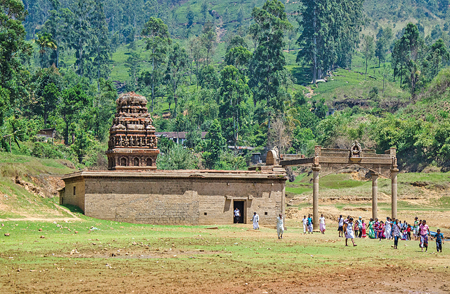
The Hindu temple in the old town of Maskeliya which was submerged
The old photograph which I possess was shot from the same location around 1800-1900 where I was standing at the reservoir bed.
Perhaps, this old photograph was taken by British tea planters of tea plantations in Maskeliya. I shot a photograph standing in the same location and then I compared it with the old one.
Although the landscape has not changed, some physical elements have changed due to the construction of the Moussekele reservoir in 1968. Comparing the two pictures, I imagined an enchanting atmosphere that must have prevailed in the bygone era of the Maskeliya town and its suburbs.
Another striking feature in the reservoir bed I visited was the magnificent Sri Shanmuganathar Swamy Hindu temple, today, known as Sri Kadireshan Hindu temple by the village folk in the Maskeliya old town.
The stone-built Hindu temple was constructed during the British rule in 1817 at the centre of the old town of Maskeliya. This temple has a history of 100 years in the plantation area.
Before the Hindu temple got submerged by the reservoir, it was a place of worship for Hindus mainly, and Buddhists. The temple was on Main Street in the Maskeliya old town on the way to Sri Pada from Hatton on the land of Brownlow Tea Estate.
Common religious centre
The Sri Sanmuganathar Swamy Hindu temple used to be a common religious centre to attract Hindu and Buddhist pilgrims to Sri Pada. In the beginning, this was the only temple for Hindus and was called ‘Kutty Kathirgamam’ by devotees. It was then administrated by Chettiyappapillai, and later handed over to his son M.T.C. Sivalingampillai.
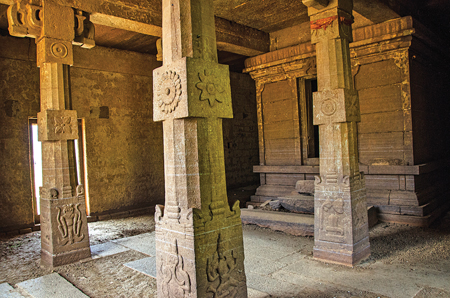
Inside of the ruined Hindu temple seen today with decorated stone columns
In the main shrine chamber, there is the old idol in the country of God Sri Shanmuganathar Swamy with six faces carved on a single stone brought from India.
It is said that this is the second idol carved with six faces of Shanmuganathar Swamy in one stone. The other is said to be somewhere else in the Northern peninsula.
However, during the Sri Pada season, this Hindu temple had become a place of worship for Buddhist pilgrims too. The old Hindu temple was submerged along with the entire Maskeliya town, in the inundation of the Maskeliya Oya to form the Moussekele hydro power reservoir in 1968.
Large numbers of Hindu pilgrims as well as Buddhists throng to the Moussekele reservoir-bed to conduct poojas officiated by a self-appointed temple priest known as Kengan when the waters of the reservoir recede and the temple resurfaces during the drought. Mostly this happens during March and April; by this time the Sri Pada season has begun and the pilgrims who return from Sri Pada reach the reservoir-bed to seek divine blessings from Hindu gods at this temple.
All the stone statues of deities except one statue which still stands in the shrine room of the ruined old temple at the reservoir bed, had been brought to the new Sri Shanmuganathar Swamy Hindu temple on the summit of the Maskeliya new town and kept for veneration.
New Hindu temple
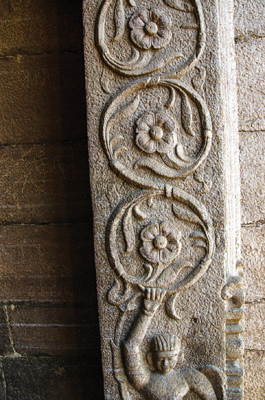
Floral motifs of stone door carvings of the submerged temple
Having climbed a series of steep steps, I reached the summit of the Maskeliya new town and entered the new Sri Sanmuganathar Swamy Hindu temple in a cramped site.
But inside it is calm and quiet, where serenity blended with devotion prevails. I worshiped the deities in each chamber in the temple. During my stay at this sacred place, I witnessed a large number of Hindu devotees coming to conduct poojas.
Every year, festivals such as Pongal, Deepavali, Nawarathri, Saraswathi poojas are conducted according to the Hindu religion, culture and rites. Apart from this, the temple conducts beautiful Thers (chariots), drawn from the temple premises through the streets of Maskeliya during the Panguni Uttaram festival which falls in April every year.
The local and foreign tourists on their way to Sri Pada stop at Maskeliya and worship at this Hindu temple in the reservoir bed of Moussekele. It is the main worship site for thousands of Hindus of the area during the drought and is one of the leading Hindu temples in the plantation estates.



